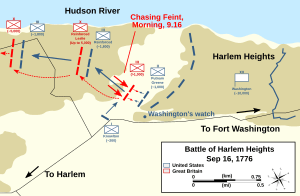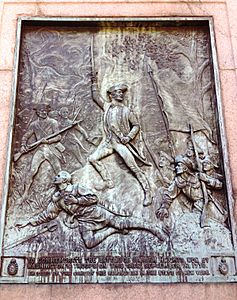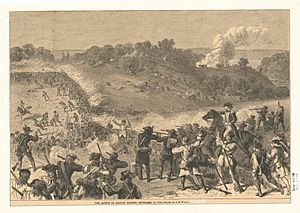Battle of Harlem Heights facts for kids
Quick facts for kids Battle of Harlem Heights |
|||||||
|---|---|---|---|---|---|---|---|
| Part of the American Revolutionary War | |||||||
 |
|||||||
|
|||||||
| Belligerents | |||||||
| Commanders and leaders | |||||||
| Strength | |||||||
| <1,800 | <1,600 | ||||||
| Casualties and losses | |||||||
| 30 killed 100 wounded |
14 killed 157 wounded |
||||||
The Battle of Harlem Heights was an important fight during the American Revolutionary War. It happened on September 16, 1776. The battle took place in what is now the Morningside Heights area of Manhattan Island in New York City.
The Continental Army, led by George Washington, had about 9,000 soldiers. They held strong positions on high ground in upper Manhattan. Facing them were about 5,000 British soldiers.
The battle started with a small fight between American scouts and British troops. The British chased the Americans, but they went too far. Washington saw a chance to trap the British. His plan didn't fully work, but the British were forced to retreat.
The British got more soldiers and fought back. The battle lasted for two hours. Finally, the British ran low on ammunition and pulled back. Washington stopped his troops from chasing them too far. This battle was a big boost for the American soldiers. It was also Washington's first victory in the war.
After this battle, there wasn't much fighting for a month. Washington later moved his army north to White Plains. This was because the British were trying to surround his army on Manhattan. After more defeats, Washington had to retreat across the Hudson River into Pennsylvania.
Contents
What Happened Before the Battle?
In August 1776, British troops defeated the American army at the Battle of Long Island. The British, led by General William Howe, trapped the Americans. General George Washington then secretly moved his entire army of 9,000 men across the East River to Manhattan.
On September 15, Howe's army landed at Kip's Bay on Manhattan's east side. British and German (Hessian) soldiers attacked. American troops ran away when they saw the enemy. Even Washington couldn't make them fight.
After this, Howe landed more soldiers. But he didn't cut off the American retreat from New York City. Washington quickly moved all his troops north. By nightfall, they reached strong defenses on Harlem Heights.
The Fight Begins
On September 16, Washington heard that the British were coming. He sent 150 men, led by Thomas Knowlton, to scout the British lines. At dawn, Knowlton's men were seen by British guards.
A small group of British soldiers attacked. The fight lasted over 30 minutes in the woods. Knowlton realized the British had more men and were trying to surround his group. He ordered his men to retreat safely.
The British chased them quickly. Knowlton's group reached the edge of the woods, looking down into a valley called the Hollow Way. This was near Washington's main position. The American scouts crossed into their own lines. The British soldiers stopped at the tree line to get organized.
British bugle calls were heard. Washington's officer, Joseph Reed, thought the calls sounded like a fox hunt. He felt it was an insult from the British.
Tricking the British
More British soldiers arrived to help their light infantry. Reed told Washington what was happening. Washington saw a chance to make his soldiers feel better. He planned to trap the British patrol.
He sent 150 volunteers to attack the British. This was a trick to make the British come down into the Hollow Way. At the same time, another group would go around the British side to cut them off.
The volunteers ran into the Hollow Way and started fighting. The British came down into the valley and fired back. More American soldiers joined the volunteers, making about 900 men. They exchanged fire, but they were too far apart to do much harm.
The group meant to go around the British side had about 200 men. They were Knowlton's Rangers and Virginia riflemen. An officer accidentally sent them to the British side, not their rear. During this attack, both Knowlton and Major Andrew Leitch were shot and badly hurt. But the American troops kept pushing forward.
A Tough Fight and American Victory
The British soldiers realized they were in danger. They retreated uphill to a fence line. Washington sent more troops into the Hollow Way. Together with the flanking group, they attacked the British from the front. The British light infantry fell back across open fields to a buckwheat field. This area is now where Barnard College stands. Here, the British got more soldiers and two small cannons.
Washington didn't want to chase the British at first. But he saw his men slowly pushing the British back. So, he sent in more soldiers and let them attack directly. Nearly 1,800 Americans were fighting in the buckwheat field. Washington's officers, like Nathanael Greene, helped direct the battle. The British also got more soldiers, but still had slightly fewer than the Americans.
The battle lasted for an hour and a half. It was fought in the field and the nearby woods. Some British units ran out of ammunition. The British then began to retreat. The Americans chased them. But Washington ordered them to stop. He was worried about facing the main British army.
When the Americans got the order to go back, they cheered loudly. They left the field in good order.
What Happened After?

The British reported 14 soldiers killed and 78 wounded. But other reports said 14 killed and 154 wounded. Historians believe the numbers were higher, possibly 90 killed and 300 wounded for the British. For the Americans, about 30 were killed and 100 wounded. This included Colonel Knowlton, who died. Major Andrew Leitch also died a few days later.
Both sides said they won. But this battle really boosted the American soldiers' spirits. Washington said it made them feel "prodigiously" better. It was also the first time Washington's army won a battle in the war.
There wasn't much fighting for the next month. But in October, Washington moved his army to White Plains. He learned the British were trying to trap him on Manhattan. After losing battles at White Plains and Fort Washington, Washington and his army had to retreat across New Jersey into Pennsylvania.
The loss of Knowlton was sad for the American army. He had created and led the first spy unit for the Continental Army. Washington had asked him to do this.



